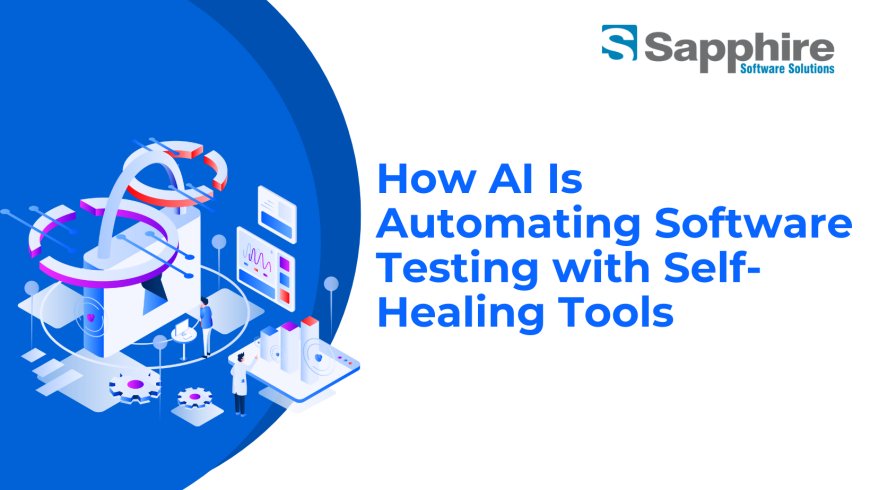How AI Is Automating Software Testing with Self-Healing Tools
AI is revolutionizing software testing through self-healing tools that automatically detect and fix broken test scripts when application changes occur. By using machine learning to identify UI elements and adapt test cases in real-time, these tools reduce maintenance, enhance reliability, and accelerate release cycles. Self-healing automation is a key advancement in enabling continuous testing within Agile and DevOps environments.

In the ever-evolving world of software development, speed, accuracy, and adaptability are non-negotiable. As organizations push for faster releases through Agile and DevOps methodologies, the need for reliable and efficient software testing has become more critical than ever. Traditional testing methods are often labor-intensive and error-prone, but Artificial Intelligence (AI) is transforming this landscape — particularly using self-healing test automation tools.
What Is Self-Healing in Software Testing?
Self-healing refers to the ability of automated tests to detect and fix issues without human intervention. In qa software testing, this means that if an automated test script breaks due to changes in the application (like a renamed button or modified layout), the tool can intelligently adapt and continue testing without manual updates.
Self-healing test automation tools leverage AI and machine learning (ML) to identify changes in the user interface (UI), understand their context, and modify test scripts accordingly. This minimizes test maintenance efforts, reduces downtime, and ensures higher reliability across software updates.
Why Traditional Test Automation Falls Short
While traditional test automation tools like Selenium and QTP have been instrumental in reducing manual testing, they come with significant limitations:
- Fragility: Automated scripts often break with minor UI changes.
- High Maintenance: Testers spend a significant amount of time updating scripts.
- Static Locators: Most tools rely on static locators (like XPath or CSS selectors), which are vulnerable to UI changes.
- Scalability Issues: As the application grows, managing large test suites becomes challenging.
These limitations can delay release cycles and inflate testing costs. AI-powered self-healing tools solve these challenges by adding a layer of intelligence to the test automation process.
How AI-Powered Self-Healing Tools Work
Self-healing automation tools use a combination of pattern recognition, element matching, and historical data to maintain tests dynamically. Here’s how they typically work:
- Element Identification Using AI
Instead of relying solely on static identifiers, self-healing tools analyze multiple attributes like element name, position, surrounding text, and behavior. AI models assign confidence scores to these elements, helping the tool identify the correct UI component even if some properties change.
- Automatic Script Repair
When a test fails due to a UI change, the self-healing mechanism attempts to find the best match for the missing element. If a suitable replacement is found, the script is updated on-the-fly, and the test will continue.
- Learning Over Time
The AI engine improves through continuous learning. It collects data from previous test runs, analyzes patterns, and becomes more accurate in predicting and correcting future issues.
- Real-Time Feedback
These tools often provide real-time dashboards and alerts, helping QA teams quickly identify and resolve test coverage gaps without sifting through logs.
Benefits of Self-Healing Test Automation
- Reduced Maintenance Costs
Automated test scripts often require frequent updates. Self-healing capabilities drastically reduce this need, freeing up QA engineers to focus on more strategic tasks.
- Faster Release Cycles
With fewer interruptions from broken scripts, testing becomes more efficient and supports faster, more frequent software releases.
- Improved Test Coverage
AI allows teams to create and maintain larger, more comprehensive test suites without proportional increases in workload.
- Higher Reliability
By automatically fixing minor issues, self-healing tools reduce false positives and make test results more trustworthy.
Popular Self-Healing Testing Tools
Several tools on the market now offer self-healing capabilities as part of their core feature set. Some of the most popular include:
- Testim – Uses AI for dynamic locators and test stability.
- Mabl – Provides intelligent test automation with built-in self-healing.
- Functionize – Combines AI with NLP for smarter test creation and healing.
- Katalon Studio – Offers self-healing in its automation testing suite.
- Parasoft Selenic – Enhances Selenium tests with AI-powered healing.
These tools are designed to integrate seamlessly into modern CI/CD pipelines, making them ideal for teams practicing continuous testing.
Future of AI in Software Testing
AI is not only enabling self-healing tests but also transforming other areas of software quality assurance:
- Test Case Generation: AI can automatically generate test cases based on application behavior and user stories.
- Defect Prediction: Machine learning models can identify high-risk areas in code that are more likely to have bugs.
- Visual Testing: AI can detect even subtle visual discrepancies that might be missed by traditional checks.
As AI continues to evolve, it will become a central force in achieving autonomous testing environments, drastically cutting down on manual intervention and enabling true continuous delivery.
Conclusion
AI-powered self-healing tools are redefining the way software testing is done. By intelligently adapting to application changes, these tools eliminate the most tedious parts of test maintenance, allowing QA teams to focus on quality, performance, and user experience. If you’re a software development company or business looking to streamline QA software testing, now’s the time to embrace AI automation. As businesses continue to adopt Agile and DevOps, leveraging self-healing automation is no longer optional — it’s essential to stay competitive in a fast-paced digital world.








